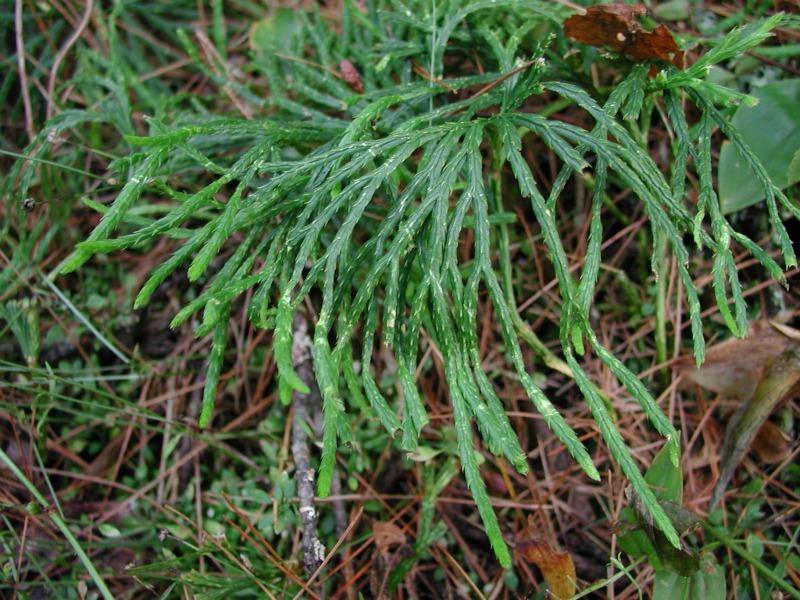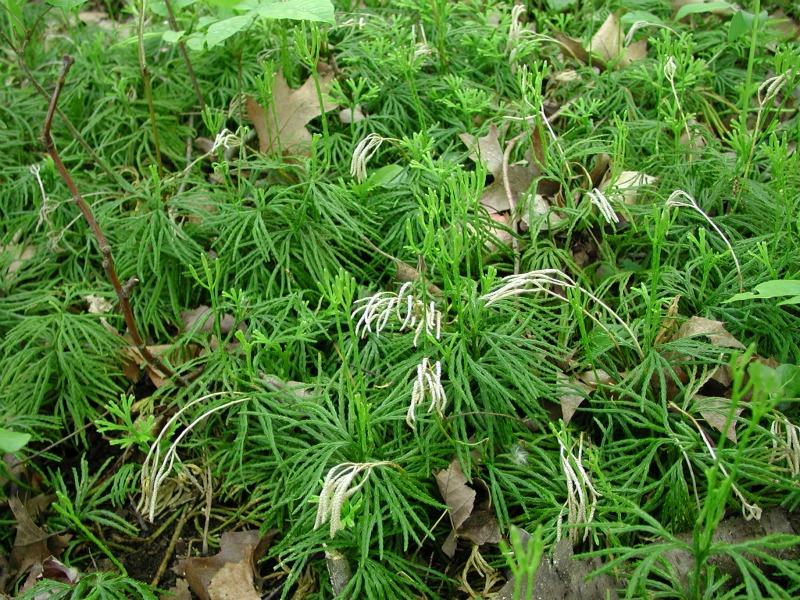Northern Ground Cedar
Diphasiastrum complanatum (L.) Holub
- Class
- Lycopodiopsida (Clubmosses)
- Family
- Lycopodiaceae (Club-moss Family)
- State Protection
- Threatened
Listed as Threatened by New York State: likely to become Endangered in the foreseeable future. For animals, taking, importation, transportation, or possession is prohibited, except under license or permit. For plants, removal or damage without the consent of the landowner is prohibited.
- Federal Protection
- Not Listed
- State Conservation Status Rank
- S2
Imperiled in New York - Very vulnerable to disappearing from New York due to rarity or other factors; typically 6 to 20 populations or locations in New York, very few individuals, very restricted range, few remaining acres (or miles of stream), and/or steep declines.
- Global Conservation Status Rank
- G5
Secure globally - Common in the world; widespread and abundant (but may be rare in some parts of its range).
Summary
Did you know?
Diphasiastrum species are part of a family of plants known as clubmosses. These "primitive" plants are living relics of some of the earliest vascular plants. There are abundant fossils of tree-sized clubmosses, sometimes depicted in displays of dinosaurs. Such specimens are closely related to the smaller clubmosses still found today (Wikipedia, accessed 5/20/2008.) The common name Northern Running-pine refers to the underground stems or "runners" which connect many plants. It is also known as Christmas Green, because it stays green throughout the year, and Ground-cedar, presumably because its appressed stems resemble the branchlets of Northern White-cedar (Thuja occidentalis).
State Ranking Justification
There are 9 existing occurrences, with 3 of those are ranked better than "fair". The 8 historical occurrences date mostly from the 1940s and 1950s.
Short-term Trends
Most of the verified sites have only been visited once, so additional work is needed to determine the trends for these populations.
Long-term Trends
There are about the same number of historical and extant occurrences, and two verified populations have apparently persisted for at least 60 yrs. This species may have always been rare in the state, where it is at the southern edge of its range.
Conservation and Management
Threats
Powerline maintenance and pollution are potential threats at two of the verified sites in the state. Succession and subsequent shading out of the population may be a long-term threat to many populations.
Habitat
Habitat
In New York this species has been found in a variety of habitats, generally in openings of some kind, including dry rocky ridgetops, powerlines, open summits and along trails through mountain spruce-fir forest in the Adirondacks, and white pine and hemlock-northern hardwood forests (New York Natural Heritage Program 2008). Dry upland forests with acidic soils (Haines and Vining 1998). Dry open coniferous or mixed forest alpine slopes (Flora of North America 1993). Woods and rocky slopes (Gleason and Cronquist 1991). Dry woods, thickets and clearings (Fernald 1970).
Associated Ecological Communities
- Alpine krummholz*
(guide)
A dwarf woodland dominated by balsam fir that occurs at or near the summits of the high peaks of the Adirondacks.
- Balsam flats*
(guide)
A conifer forest that occurs on moist, well-drained soils of low flats adjoining swamps, gentle low ridges, and knolls within swamps. The dominant tree is balsam fir, which occurs either in pure stands or in mixed stands with red spruce or black spruce.
- Hemlock-northern hardwood forest
(guide)
A mixed forest that typically occurs on middle to lower slopes of ravines, on cool, mid-elevation slopes, and on moist, well-drained sites at the margins of swamps. Eastern hemlock is present and is often the most abundant tree in the forest.
- Mountain fir forest*
(guide)
A conifer forest that occurs at high elevations in the Catskill and Adirondack mountains, usually at elevations ranging from 3500 to 4500 ft. This forest typically occurs on cool upper slopes that are exposed to wind, at elevations above spruce-northern hardwood forests, usually above mountain spruce fir forest, and below alpine krummholz. The vegetation typically has a low species diversity; the tree layer is almost entirely balsam fir.
- Pine-northern hardwood forest*
(guide)
A mixed forest that occurs on gravelly outwash plains, delta sands, eskers, and dry lake sands in the Adirondacks. The dominant trees are white pine and red pine.
- Red pine rocky summit*
(guide)
A community that occurs on cool, dry, rocky ridgetops and summits where the bedrock is non-calcareous and the soils are more or less acidic. Red pine is typically dominant, but may also be codominant with red oak and/or white pine.
- Spruce-fir rocky summit*
(guide)
A community that occurs on cool, dry, rocky ridgetops and summits where the bedrock is non-calcareous (such as anorthosite, quartzite, or sandstone), and the soils are more or less acidic. The vegetation may be sparse or patchy, with numerous rock outcrops and rock slides. The species have predominantly boreal distributions.
* probable association but not confirmed.
Associated Species
- Abies balsamea (balsam fir)
- Acer rubrum
- Amelanchier
- Betula alleghaniensis (yellow birch)
- Fagus grandifolia (American beech)
- Picea
- Quercus
- Tsuga canadensis (eastern hemlock)
- Vaccinium
Range
New York State Distribution
This species is known from the northeastern Adirondacks, the Tug Hill Plateau, and Finger Lakes regions in northern New York, and Ulster and Sullivan counties to the south.
Global Distribution
Northern Running-pine is a circumboreal species, ranging throughout much of Canada and extending south into the U.S. in the Pacific Northwest, the Upper Great Lakes, and northern New York and New England.
Identification Comments
General Description
Northern Running-pine is a perennial, evergreen plant which spreads by horizontal stems 1.1 to 2.2mm wide, prostate on the ground or buried under leaf litter. The upright shoots grow 8 to 44 cm tall, and are branched irregularly up to 5 times. They have a distinct "unkempt" look to them instead of forming neatly arranged tiers. The leaves are 1.4 to 4 mm long by .5 to 1.2 mm wide, appressed, and narrowly lance-shaped with acute tips. The leaves are arranged into 4 ranks, forming flattened "branchlets" 1.8 to 4 mm wide, with regular bud constrictions representing the extent of the annual growth. The uppersides of the branchlets are green and faintly shiny, the undersides pale and dull. Diphasiastrum and its relatives produce spores rather than seeds. In D. complanatum, these are borne on 1-2 stalked strobili per shoot, each strobilus 8.3 to 32 mm long by 2-3 mm wide, with a blunt apex.
Best Life Stage for Proper Identification
Individuals with strobili are best for identification, but shoots with leaves only may also be identified.
Similar Species
Diphasiastrum digitatum does not have branches with annual constrictions, and the branches are organized into distinct tiers. Diphasiastrum tristachyum does have annual constrictions, but has narrower (1.2 to 2.0 mm) branches that are blue-green (especially beneath), and peduncles each with 3-4 strobili. D. complanatum has branches 2 to 3 mm wide and not in distinct tiers, 1-2 strobili per peduncle, and a shiny green color.
Also, the tips of the leaves on the lower surface of the branches reach the base of the leaves above them. In D. digitatum and D. complanatum the tips of these leaves do not reach the base of the leaves above them. (FNA 1993, Haines and Vining 1998).
Best Time to See
Vegetative plants may be found year-round when they are not covered by snow but are most visible late April through November. Spore-bearing plants can be found during the summer months.
- Vegetative
- Fruiting
The time of year you would expect to find Northern Ground Cedar vegetative and fruiting in New York.
Northern Ground Cedar Images
Images of Similar Species
Taxonomy
Northern Ground Cedar
Diphasiastrum complanatum (L.) Holub
- Kingdom Plantae
- Phylum Lycophyta
- Class Lycopodiopsida
(Clubmosses)
- Order Lycopodiales
- Family Lycopodiaceae (Club-moss Family)
- Order Lycopodiales
- Class Lycopodiopsida
(Clubmosses)
- Phylum Lycophyta
Additional Common Names
- Christmas Green
- Ground-cedar
- Northern Running-pine
Synonyms
- Diphasium complanatum (L.) Rothm.
- Lycopodium complanatum L.
- Lycopodium complanatum var. complanatum
Comments on the Classification
Diphasiastrum was formerly considered part of the genus Lycopodium, and this species may be found under the name Lycopodium complanatum in some guides. Lycopodium digitatum, formerly known as L. complanatum var. flabelliforme, often appears in old plant lists as simply L. complanatum.
Additional Resources
References
Edinger, Gregory J., D.J. Evans, Shane Gebauer, Timothy G. Howard, David M. Hunt, and Adele M. Olivero (editors). 2002. Ecological Communities of New York State. Second Edition. A revised and expanded edition of Carol Reschke's Ecological Communities of New York State. (Draft for review). New York Natural Heritage Program, New York State Department of Environmental Conservation. Albany, NY. 136 pp.
Fernald, M.L. 1950. Gray's manual of botany. 8th edition. D. Van Nostrand, New York. 1632 pp.
Flora of North America Editorial Committee. 1993. Flora of North America, North of Mexico. Volume 2. Pteridophytes and Gymnosperms. Oxford University Press, New York. 475 pp.
Gleason, Henry A. and A. Cronquist. 1991. Manual of Vascular Plants of Northeastern United States and Adjacent Canada. The New York Botanical Garden, Bronx, New York. 910 pp.
Haines, A. and T.F. Vining. 1998. Flora of Maine, A Manual for Identification of Native and Naturalized Vascular Plants of Maine. V.F.Thomas Co., Bar Harbor, Maine.
Holmgren, Noel. 1998. The Illustrated Companion to Gleason and Cronquist's Manual. Illustrations of the Vascular Plants of Northeastern United States and Adjacent Canada. The New York Botanical Garden, Bronx, New York.
Mitchell, Richard S. 1986. A checklist of New York State plants. Bulletin No. 458. New York State Museum. 272 pp.
Mitchell, Richard S. and Gordon C. Tucker. 1997. Revised Checklist of New York State Plants. Contributions to a Flora of New York State. Checklist IV. Bulletin No. 490. New York State Museum. Albany, NY. 400 pp.
New York Natural Heritage Program. 2010. Biotics database. New York Natural Heritage Program. New York State Department of Environmental Conservation. Albany, NY.
New York Natural Heritage Program. 2024. New York Natural Heritage Program Databases. Albany, NY.
Weldy, T. and D. Werier. 2010. New York flora atlas. [S.M. Landry, K.N. Campbell, and L.D. Mabe (original application development), Florida Center for Community Design and Research http://www.fccdr.usf.edu/. University of South Florida http://www.usf.edu/]. New York Flora Association http://newyork.plantatlas.usf.edu/, Albany, New York
Weldy, Troy W. and David Werier. 2005. New York Flora Atlas. [S.M. Landry, K.N. Campbell, and L.D. Mabe (original application development), Florida Center for Community Design and Research. University of South Florida]. New York Flora Association, Albany, NY. Available on the web at (http://newyork.plantatlas.usf.edu/).
Links
About This Guide
Information for this guide was last updated on: October 22, 2020
Please cite this page as:
New York Natural Heritage Program. 2024.
Online Conservation Guide for
Diphasiastrum complanatum.
Available from: https://guides.nynhp.org/northern-running-pine/.
Accessed July 26, 2024.

